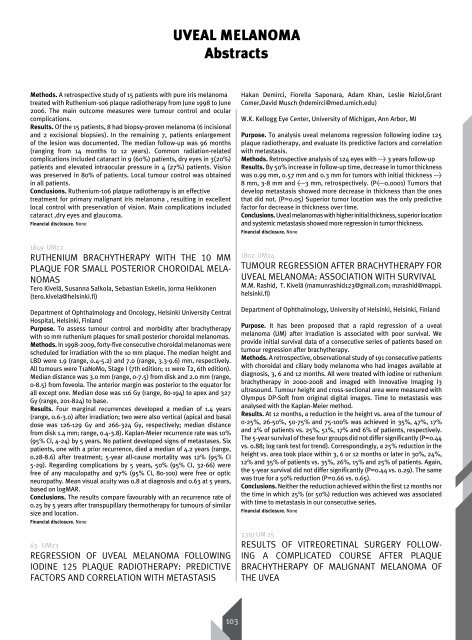Program Book
Program Book
Program Book
You also want an ePaper? Increase the reach of your titles
YUMPU automatically turns print PDFs into web optimized ePapers that Google loves.
Methods. A retrospective study of 15 patients with pure iris melanoma<br />
treated with Ruthenium-106 plaque radiotherapy from June 1998 to June<br />
2006. The main outcome measures were tumour control and ocular<br />
complications.<br />
Results. Of the 15 patients, 8 had biopsy-proven melanoma (6 incisional<br />
and 2 excisional biopsies). In the remaining 7, patients enlargement<br />
of the lesion was documented. The median follow-up was 96 months<br />
(ranging from 14 months to 12 years). Common radiation-related<br />
complications included cataract in 9 (60%) patients, dry eyes in 3(20%)<br />
patients and elevated intraocular pressure in 4 (27%) patients. Vision<br />
was preserved in 80% of patients. Local tumour control was obtained<br />
in all patients.<br />
Conclusions. Ruthenium-106 plaque radiotherapy is an effective<br />
treatment for primary malignant iris melanoma , resulting in excellent<br />
local control with preservation of vision. Main complications included<br />
cataract ,dry eyes and glaucoma.<br />
Financial disclosure. None<br />
1849 UM22<br />
RUTHENIUM BRACHYTHERAPY WITH THE 10 MM<br />
PLAQUE FOR SMALL POSTERIOR CHOROIDAL MELA-<br />
NOMAS<br />
Tero Kivelä, Susanna Salkola, Sebastian Eskelin, Jorma Heikkonen<br />
(tero.kivela@helsinki.fi)<br />
Department of Ophthalmology and Oncology, Helsinki University Central<br />
Hospital, Helsinki, Finland<br />
Purpose. To assess tumour control and morbidity after brachytherapy<br />
with 10 mm ruthenium plaques for small posterior choroidal melanomas.<br />
Methods. In 1998-2009, forty-five consecutive choroidal melanomas were<br />
scheduled for irradiation with the 10 mm plaque. The median height and<br />
LBD were 1.9 (range, 0.4-5.2) and 7.0 (range, 3.3-9.6) mm, respectively.<br />
All tumours were T1aN0M0, Stage I (7th edition; 11 were T2, 6th edition).<br />
Median distance was 3.0 mm (range, 0-7.5) from disk and 2.0 mm (range,<br />
0-8.5) from foveola. The anterior margin was posterior to the equator for<br />
all except one. Median dose was 116 Gy (range, 80-194) to apex and 327<br />
Gy (range, 201-824) to base.<br />
Results. Four marginal recurrences developed a median of 1.4 years<br />
(range, 0.6-3.0) after irradiation; two were also vertical (apical and basal<br />
dose was 126-129 Gy and 266-324 Gy, respectively; median distance<br />
from disk 1.4 mm; range, 0.4-3.8). Kaplan-Meier recurrence rate was 10%<br />
(95% CI, 4-24) by 5 years. No patient developed signs of metastases. Six<br />
patients, one with a prior recurrence, died a median of 4.2 years (range,<br />
0.28-8.6) after treatment; 5-year all-cause mortality was 12% (95% CI<br />
5-29). Regarding complications by 5 years, 50% (95% CI, 32-66) were<br />
free of any maculopathy and 97% (95% CI, 80-100) were free or optic<br />
neuropathy. Mean visual acuity was 0.8 at diagnosis and 0.63 at 5 years,<br />
based on logMAR.<br />
Conclusions. The results compare favourably with an recurrence rate of<br />
0.25 by 5 years after transpupillary thermotherapy for tumours of similar<br />
size and location.<br />
Financial disclosure. None<br />
63 UM23<br />
REGRESSION OF UVEAL MELANOMA FOLLOWING<br />
IODINE 125 PLAQUE RADIOTHERAPY: PREDICTIVE<br />
FACTORS AND CORRELATION WITH METASTASIS<br />
UVEAL MELANOMA<br />
Abstracts<br />
103<br />
Hakan Demirci, Fiorella Saponara, Adam Khan, Leslie Niziol,Grant<br />
Comer,David Musch (hdemirci@med.umich.edu)<br />
W.K. Kellogg Eye Center, University of Michigan, Ann Arbor, MI<br />
Purpose. To analysis uveal melanoma regression following iodine 125<br />
plaque radiotherapy, and evaluate its predictive factors and correlation<br />
with metastasis.<br />
Methods. Retrospective analysis of 124 eyes with > 3 years follow-up<br />
Results. By 50% increase in follow-up time, decrease in tumor thickness<br />
was 0.99 mm, 0.57 mm and 0.3 mm for tumors with initial thickness ><br />
8 mm, 3-8 mm and


